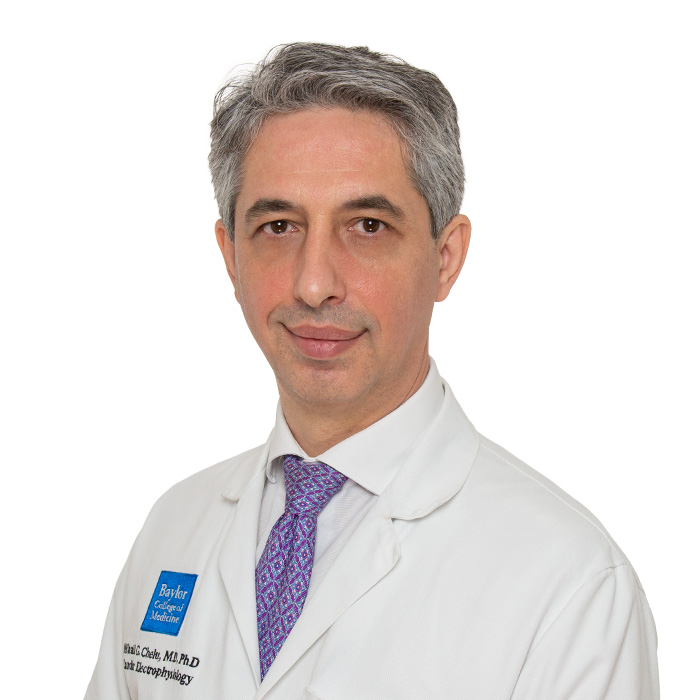
Mihail G. Chelu, MD, PhD, FHRS
Mihail G. Chelu, MD, PhD, FHRS
Associate Professor
Director of Electrophysiology, Baylor Heart Clinic
Director of Clinical Electrophysiology Research, Baylor College of Medicine
Medical Director, Inherited Arrhythmia and Cardiomyopathy Clinic
Associate Director, Texas Heart Institute Clinical Cardiac Electrophysiology Fellowship at Baylor St. Luke’s Medical Center
(Houston, Texas)
Hide full bio
Texas Heart Institute Positions
- Associate Program Director, Clinical Cardiac Electrophysiology Fellowship
Interests
Academic & Clinical Affiliations
Honors, Awards and Memberships
Publications
4862227
IWA9EES7
1
alternatives-to-animal-experimentation
10
date
desc
Chelu
27813
https://www.texasheart.org/wp-content/plugins/zotpress/
%7B%22status%22%3A%22success%22%2C%22updateneeded%22%3Afalse%2C%22instance%22%3Afalse%2C%22meta%22%3A%7B%22request_last%22%3A0%2C%22request_next%22%3A0%2C%22used_cache%22%3Atrue%7D%2C%22data%22%3A%5B%7B%22key%22%3A%22W59RFEA8%22%2C%22library%22%3A%7B%22id%22%3A4862227%7D%2C%22meta%22%3A%7B%22creatorSummary%22%3A%22Vijayaraman%20et%20al.%22%2C%22parsedDate%22%3A%222023-07-18%22%2C%22numChildren%22%3A1%7D%2C%22bib%22%3A%22%26lt%3Bdiv%20class%3D%26quot%3Bcsl-bib-body%26quot%3B%20style%3D%26quot%3Bline-height%3A%201.35%3B%20padding-left%3A%201em%3B%20text-indent%3A-1em%3B%26quot%3B%26gt%3B%5Cn%20%20%26lt%3Bdiv%20class%3D%26quot%3Bcsl-entry%26quot%3B%26gt%3BVijayaraman%2C%20P.%2C%20Sharma%2C%20P.%20S.%2C%20Cano%2C%20%26%23xD3%3B.%20et%20al.%20%282023%29.%20Comparison%20of%20left%20bundle%20branch%20area%26%23xA0%3Bpacing%20and%20biventricular%20pacing%26%23xA0%3Bin%26%23xA0%3Bcandidates%20for%20resynchronization%20therapy.%20%26lt%3Bi%26gt%3BJ%20Am%20Coll%20Cardiol%26lt%3B%5C%2Fi%26gt%3B%20%26lt%3Bi%26gt%3B82%26lt%3B%5C%2Fi%26gt%3B%2C%20228%26%23x2013%3B241.%20%26lt%3Ba%20class%3D%26%23039%3Bzp-DOIURL%26%23039%3B%20href%3D%26%23039%3Bhttps%3A%5C%2F%5C%2Fdoi.org%5C%2F10.1016%5C%2Fj.jacc.2023.05.006%26%23039%3B%26gt%3Bhttps%3A%5C%2F%5C%2Fdoi.org%5C%2F10.1016%5C%2Fj.jacc.2023.05.006%26lt%3B%5C%2Fa%26gt%3B.%26lt%3B%5C%2Fdiv%26gt%3B%5Cn%26lt%3B%5C%2Fdiv%26gt%3B%22%2C%22data%22%3A%7B%22itemType%22%3A%22journalArticle%22%2C%22title%22%3A%22Comparison%20of%20left%20bundle%20branch%20area%5Cu00a0pacing%20and%20biventricular%20pacing%5Cu00a0in%5Cu00a0candidates%20for%20resynchronization%20therapy%22%2C%22creators%22%3A%5B%7B%22creatorType%22%3A%22author%22%2C%22firstName%22%3A%22Pugazhendhi%22%2C%22lastName%22%3A%22Vijayaraman%22%7D%2C%7B%22creatorType%22%3A%22author%22%2C%22firstName%22%3A%22Parikshit%20S.%22%2C%22lastName%22%3A%22Sharma%22%7D%2C%7B%22creatorType%22%3A%22author%22%2C%22firstName%22%3A%22%5Cu00d3scar%22%2C%22lastName%22%3A%22Cano%22%7D%2C%7B%22creatorType%22%3A%22author%22%2C%22firstName%22%3A%22Shunmuga%20Sundaram%22%2C%22lastName%22%3A%22Ponnusamy%22%7D%2C%7B%22creatorType%22%3A%22author%22%2C%22firstName%22%3A%22Bengt%22%2C%22lastName%22%3A%22Herweg%22%7D%2C%7B%22creatorType%22%3A%22author%22%2C%22firstName%22%3A%22Francesco%22%2C%22lastName%22%3A%22Zanon%22%7D%2C%7B%22creatorType%22%3A%22author%22%2C%22firstName%22%3A%22Marek%22%2C%22lastName%22%3A%22Jastrzebski%22%7D%2C%7B%22creatorType%22%3A%22author%22%2C%22firstName%22%3A%22Jiangang%22%2C%22lastName%22%3A%22Zou%22%7D%2C%7B%22creatorType%22%3A%22author%22%2C%22firstName%22%3A%22Mihail%20G.%22%2C%22lastName%22%3A%22Chelu%22%7D%2C%7B%22creatorType%22%3A%22author%22%2C%22firstName%22%3A%22Kevin%22%2C%22lastName%22%3A%22Vernooy%22%7D%2C%7B%22creatorType%22%3A%22author%22%2C%22firstName%22%3A%22Zachary%20I.%22%2C%22lastName%22%3A%22Whinnett%22%7D%2C%7B%22creatorType%22%3A%22author%22%2C%22firstName%22%3A%22Girish%20M.%22%2C%22lastName%22%3A%22Nair%22%7D%2C%7B%22creatorType%22%3A%22author%22%2C%22firstName%22%3A%22Manuel%22%2C%22lastName%22%3A%22Molina-Lerma%22%7D%2C%7B%22creatorType%22%3A%22author%22%2C%22firstName%22%3A%22Karol%22%2C%22lastName%22%3A%22Curila%22%7D%2C%7B%22creatorType%22%3A%22author%22%2C%22firstName%22%3A%22Dipen%22%2C%22lastName%22%3A%22Zalavadia%22%7D%2C%7B%22creatorType%22%3A%22author%22%2C%22firstName%22%3A%22Abdul%22%2C%22lastName%22%3A%22Haseeb%22%7D%2C%7B%22creatorType%22%3A%22author%22%2C%22firstName%22%3A%22Cicely%22%2C%22lastName%22%3A%22Dye%22%7D%2C%7B%22creatorType%22%3A%22author%22%2C%22firstName%22%3A%22Sharath%20C.%22%2C%22lastName%22%3A%22Vipparthy%22%7D%2C%7B%22creatorType%22%3A%22author%22%2C%22firstName%22%3A%22Ryan%22%2C%22lastName%22%3A%22Brunetti%22%7D%2C%7B%22creatorType%22%3A%22author%22%2C%22firstName%22%3A%22Pawel%22%2C%22lastName%22%3A%22Moskal%22%7D%2C%7B%22creatorType%22%3A%22author%22%2C%22firstName%22%3A%22Alexandra%22%2C%22lastName%22%3A%22Ross%22%7D%2C%7B%22creatorType%22%3A%22author%22%2C%22firstName%22%3A%22Antonius%22%2C%22lastName%22%3A%22van%20Stipdonk%22%7D%2C%7B%22creatorType%22%3A%22author%22%2C%22firstName%22%3A%22Jerin%22%2C%22lastName%22%3A%22George%22%7D%2C%7B%22creatorType%22%3A%22author%22%2C%22firstName%22%3A%22Yusuf%20K.%22%2C%22lastName%22%3A%22Qadeer%22%7D%2C%7B%22creatorType%22%3A%22author%22%2C%22firstName%22%3A%22Mishal%22%2C%22lastName%22%3A%22Mumtaz%22%7D%2C%7B%22creatorType%22%3A%22author%22%2C%22firstName%22%3A%22Jeffrey%22%2C%22lastName%22%3A%22Kolominsky%22%7D%2C%7B%22creatorType%22%3A%22author%22%2C%22firstName%22%3A%22Syeda%20A.%22%2C%22lastName%22%3A%22Zahra%22%7D%2C%7B%22creatorType%22%3A%22author%22%2C%22firstName%22%3A%22Mehrdad%22%2C%22lastName%22%3A%22Golian%22%7D%2C%7B%22creatorType%22%3A%22author%22%2C%22firstName%22%3A%22Lina%22%2C%22lastName%22%3A%22Marcantoni%22%7D%2C%7B%22creatorType%22%3A%22author%22%2C%22firstName%22%3A%22Faiz%20A.%22%2C%22lastName%22%3A%22Subzposh%22%7D%2C%7B%22creatorType%22%3A%22author%22%2C%22firstName%22%3A%22Kenneth%20A.%22%2C%22lastName%22%3A%22Ellenbogen%22%7D%5D%2C%22abstractNote%22%3A%22BACKGROUND%3A%20Cardiac%20resynchronization%20therapy%20%28CRT%29%20with%20biventricular%20pacing%20%28BVP%29%20is%20a%20well%20established%20therapy%20in%20patients%20with%20reduced%20left%20ventricular%20ejection%20fraction%20%28LVEF%29%2C%20heart%20failure%2C%20and%20wide%20QRS%20or%20expected%20frequent%20ventricular%20pacing.%20Left%20bundle%20branch%20area%20pacing%20%28LBBAP%29%20has%20recently%20been%20shown%20to%20be%20a%20safe%20alternative%20to%20BVP.%5CnOBJECTIVES%3A%20The%20aim%20of%20this%20study%20was%20to%20compare%20the%20clinical%20outcomes%20between%20BVP%20and%20LBBAP%20among%20patients%20undergoing%20CRT.%5CnMETHODS%3A%20This%20observational%20study%20included%20patients%20with%20LVEF%5Cu00a0%5Cu226435%25%20who%20underwent%20BVP%20or%20LBBAP%20for%20the%20first%20time%20for%20Class%20I%20or%20II%20indications%20for%20CRT%20from%20January%202018%20to%20June%202022%20at%2015%20international%20centers.%20The%20primary%20outcome%20was%20the%20composite%20endpoint%20of%20time%20to%20death%20or%20heart%20failure%20hospitalization%20%28HFH%29.%20Secondary%20outcomes%20included%20endpoints%20of%20death%2C%20HFH%2C%20and%20echocardiographic%20changes.%5CnRESULTS%3A%20A%20total%20of%201%2C778%20patients%20met%20inclusion%20criteria%3A%20981%20BVP%2C%20797%20LBBAP.%20The%20mean%20age%20was%2069%20%5Cu00b1%2012%20years%2C%2032%25%20were%20female%2C%2048%25%20had%20coronary%20artery%20disease%2C%20and%20mean%20LVEF%20was%2027%25%20%5Cu00b1%206%25.%20Paced%20QRS%20duration%20in%20LBBAP%20was%20significantly%20narrower%20than%20baseline%20%28128%20%5Cu00b1%2019%5Cu00a0ms%20vs%20161%20%5Cu00b1%2028%5Cu00a0ms%3B%20P%5Cu00a0%26lt%3B%200.001%29%20and%20significantly%20narrower%20compared%20to%20BVP%20%28144%20%5Cu00b1%2023%5Cu00a0ms%3B%20P%5Cu00a0%26lt%3B%200.001%29.%20Following%20CRT%2C%20LVEF%20improved%20from%2027%25%20%5Cu00b1%206%25%20to%2041%25%20%5Cu00b1%2013%25%20%28P%5Cu00a0%26lt%3B%200.001%29%20with%20LBBAP%20compared%20with%20an%20increase%20from%2027%25%20%5Cu00b1%207%25%20to%2037%25%20%5Cu00b1%2012%25%20%28P%5Cu00a0%26lt%3B%200.001%29%20with%20BVP%2C%20with%20significantly%20greater%20change%20from%20baseline%20with%20LBBAP%20%2813%25%20%5Cu00b1%2012%25%20vs%2010%25%20%5Cu00b1%2012%25%3B%20P%5Cu00a0%26lt%3B%200.001%29.%20On%20multivariable%20regression%20analysis%2C%20the%20primary%20outcome%20was%20significantly%20reduced%20with%20LBBAP%20compared%20with%20BVP%20%2820.8%25%20vs%2028%25%3B%20HR%3A%201.495%3B%2095%25%5Cu00a0CI%3A%201.213-1.842%3B%20P%5Cu00a0%26lt%3B%200.001%29.%5CnCONCLUSIONS%3A%20LBBAP%20improved%20clinical%20outcomes%20compared%20with%20BVP%20in%20patients%20with%20CRT%20indications%20and%20may%20be%20a%20reasonable%20alternative%20to%20BVP.%22%2C%22date%22%3A%222023-07-18%22%2C%22language%22%3A%22eng%22%2C%22DOI%22%3A%2210.1016%5C%2Fj.jacc.2023.05.006%22%2C%22ISSN%22%3A%221558-3597%22%2C%22url%22%3A%22%22%2C%22collections%22%3A%5B%22IWA9EES7%22%2C%22Q46ISS7S%22%5D%2C%22dateModified%22%3A%222023-07-21T19%3A10%3A07Z%22%7D%7D%2C%7B%22key%22%3A%228RU4J6T4%22%2C%22library%22%3A%7B%22id%22%3A4862227%7D%2C%22meta%22%3A%7B%22creatorSummary%22%3A%22Kim%20et%20al.%22%2C%22parsedDate%22%3A%222023-07%22%2C%22numChildren%22%3A2%7D%2C%22bib%22%3A%22%26lt%3Bdiv%20class%3D%26quot%3Bcsl-bib-body%26quot%3B%20style%3D%26quot%3Bline-height%3A%201.35%3B%20padding-left%3A%201em%3B%20text-indent%3A-1em%3B%26quot%3B%26gt%3B%5Cn%20%20%26lt%3Bdiv%20class%3D%26quot%3Bcsl-entry%26quot%3B%26gt%3BKim%2C%20S.%20E.%2C%20Khawaja%2C%20M.%2C%20Kim%2C%20J.%20A.%20et%20al.%20%282023%29.%20Detection%20of%20atrial%20fibrillation%20in%20real%20world%20setting%20in%20patients%20with%20cryptogenic%20stroke%20and%20an%20implantable%20loop%20recorder.%20%26lt%3Bi%26gt%3BPacing%20Clin%20Electrophysiol%26lt%3B%5C%2Fi%26gt%3B%20%26lt%3Bi%26gt%3B46%26lt%3B%5C%2Fi%26gt%3B%2C%20788%26%23x2013%3B795.%20%26lt%3Ba%20class%3D%26%23039%3Bzp-DOIURL%26%23039%3B%20href%3D%26%23039%3Bhttps%3A%5C%2F%5C%2Fdoi.org%5C%2F10.1111%5C%2Fpace.14757%26%23039%3B%26gt%3Bhttps%3A%5C%2F%5C%2Fdoi.org%5C%2F10.1111%5C%2Fpace.14757%26lt%3B%5C%2Fa%26gt%3B.%26lt%3B%5C%2Fdiv%26gt%3B%5Cn%26lt%3B%5C%2Fdiv%26gt%3B%22%2C%22data%22%3A%7B%22itemType%22%3A%22journalArticle%22%2C%22title%22%3A%22Detection%20of%20atrial%20fibrillation%20in%20real%20world%20setting%20in%20patients%20with%20cryptogenic%20stroke%20and%20an%20implantable%20loop%20recorder%22%2C%22creators%22%3A%5B%7B%22creatorType%22%3A%22author%22%2C%22firstName%22%3A%22Seulgi%20Erica%22%2C%22lastName%22%3A%22Kim%22%7D%2C%7B%22creatorType%22%3A%22author%22%2C%22firstName%22%3A%22Muzamil%22%2C%22lastName%22%3A%22Khawaja%22%7D%2C%7B%22creatorType%22%3A%22author%22%2C%22firstName%22%3A%22Jitae%20Alex%22%2C%22lastName%22%3A%22Kim%22%7D%2C%7B%22creatorType%22%3A%22author%22%2C%22firstName%22%3A%22Payam%22%2C%22lastName%22%3A%22Safavi-Naeini%22%7D%2C%7B%22creatorType%22%3A%22author%22%2C%22firstName%22%3A%22June%22%2C%22lastName%22%3A%22Pickett%22%7D%2C%7B%22creatorType%22%3A%22author%22%2C%22firstName%22%3A%22Joanna%22%2C%22lastName%22%3A%22Molina-Razavi%22%7D%2C%7B%22creatorType%22%3A%22author%22%2C%22firstName%22%3A%22Mohammad%22%2C%22lastName%22%3A%22Saeed%22%7D%2C%7B%22creatorType%22%3A%22author%22%2C%22firstName%22%3A%22Mehdi%22%2C%22lastName%22%3A%22Razavi%22%7D%2C%7B%22creatorType%22%3A%22author%22%2C%22firstName%22%3A%22Abdi%22%2C%22lastName%22%3A%22Rasekh%22%7D%2C%7B%22creatorType%22%3A%22author%22%2C%22firstName%22%3A%22Mihail%22%2C%22lastName%22%3A%22Chelu%22%7D%5D%2C%22abstractNote%22%3A%22INTRODUCTION%3A%20Implantable%20loop%20recorders%20%28ILR%29%20are%20used%20to%20screen%20for%20atrial%20fibrillation%20%28AF%29%20in%20patients%20with%20cryptogenic%20stroke%20%28CS%29.%20However%2C%20there%20is%20limited%20real-world%20data%20regarding%20the%20long-term%20rate%20of%20AF%20detection%20using%20ILR%20and%20management%20consequences%20in%20patients%20with%20CS.%20The%20objective%20is%20to%20assess%20the%20rate%20of%20AF%20detection%20in%20patients%20with%20CS%20in%20a%20real-world%20study%20over%2036%20months%20of%20follow-up%20and%20its%20consequences%20on%20stroke%20prevention.%5CnMETHODS%3A%20This%20retrospective%20study%20included%20patients%20with%20an%20ILR%20placed%20for%20CS%20at%20Baylor%20College%20of%20Medicine%20and%20Baylor%20St.%20Luke%26%23039%3Bs%20Medical%20Center%20between%20January%202014%20and%20July%202021.%20The%20primary%20outcome%20was%20AF%20detection%20in%20patients%20with%20ILR.%20The%20secondary%20outcome%20was%20the%20rate%20of%20subsequent%20strokes%20after%20ILR%20placement%20in%20patients%20with%20or%20without%20diagnosed%20AF.%20The%20AF%20detection%20rate%20in%20our%20cohort%20was%20compared%20to%20the%20rate%20in%20CRYSTAL-AF%20Trial%20at%2036-month%20follow-up.%20The%20impact%20of%20AF%20detection%20on%20clinical%20management%20was%20examined.%5CnRESULTS%3A%20We%20identified%20225%20patients.%2051.1%25%20were%20women%20and%2038.2%25%20African%20American.%20Among%2085%20patients%20with%20ILR%20labeled%20AF%2C%2043%20patients%20had%20true%20AF%2C%20and%2042%20had%20incorrectly%20labeled%20AF%20%2848.3%25%20false%20positive%29.%20The%20estimated%20AF%20detection%20rate%20at%2036%20months%20follow-up%20was%2028.6%25%20%2895%25%20CI%2C%2026.6%25-30.6%25%29.%2058.1%25%20of%20patients%20with%20AF%20were%20initiated%20on%20oral%20anticoagulation%2C%2080.0%25%20of%20whom%20were%20started%20on%20a%20direct%20oral%20anticoagulant.%2013.8%25%20of%20patients%20had%20recurrent%20strokes%20after%20ILR%20implantation%3B%204%20of%20whom%20were%20diagnosed%20with%20AF.%5CnCONCLUSION%3A%20Compared%20to%20CRYSTAL-AF%2C%20the%20AF%20detection%20rate%20in%20our%20cohort%20is%20similar%2C%20but%20this%20cohort%20includes%20a%20higher%20proportion%20of%20female%20and%20African%20American%20patients.%20Most%20patients%20with%20recurrent%20strokes%20after%20ILR%20implant%20did%20not%20have%20AF%20during%2036%20months%20of%20monitoring.%22%2C%22date%22%3A%222023-07%22%2C%22language%22%3A%22eng%22%2C%22DOI%22%3A%2210.1111%5C%2Fpace.14757%22%2C%22ISSN%22%3A%221540-8159%22%2C%22url%22%3A%22%22%2C%22collections%22%3A%5B%22MQPA457U%22%2C%22DYX9DYCW%22%2C%22HXDL45T9%22%2C%22Q5SGFS6G%22%2C%22IWA9EES7%22%2C%22JXX9UD5K%22%2C%22Q46ISS7S%22%5D%2C%22dateModified%22%3A%222023-07-21T18%3A37%3A37Z%22%7D%7D%2C%7B%22key%22%3A%229Y96GPSQ%22%2C%22library%22%3A%7B%22id%22%3A4862227%7D%2C%22meta%22%3A%7B%22creatorSummary%22%3A%22Kim%20and%20Chelu%22%2C%22parsedDate%22%3A%222023-05-01%22%2C%22numChildren%22%3A2%7D%2C%22bib%22%3A%22%26lt%3Bdiv%20class%3D%26quot%3Bcsl-bib-body%26quot%3B%20style%3D%26quot%3Bline-height%3A%201.35%3B%20padding-left%3A%201em%3B%20text-indent%3A-1em%3B%26quot%3B%26gt%3B%5Cn%20%20%26lt%3Bdiv%20class%3D%26quot%3Bcsl-entry%26quot%3B%26gt%3BKim%2C%20J.%20A.%20and%20%26lt%3Bstrong%26gt%3BChelu%26lt%3B%5C%2Fstrong%26gt%3B%2C%20M.%20G.%20%282023%29.%20Conduction%20system%20pacing%20for%20cardiac%20resynchronization%20therapy%3A%20The%2031-million-dollar%20question.%20%26lt%3Bi%26gt%3BTex%20Heart%20Inst%20J%26lt%3B%5C%2Fi%26gt%3B%20%26lt%3Bi%26gt%3B50%26lt%3B%5C%2Fi%26gt%3B%2C%20e238118.%20%26lt%3Ba%20class%3D%26%23039%3Bzp-DOIURL%26%23039%3B%20href%3D%26%23039%3Bhttps%3A%5C%2F%5C%2Fdoi.org%5C%2F10.14503%5C%2FTHIJ-23-8118%26%23039%3B%26gt%3Bhttps%3A%5C%2F%5C%2Fdoi.org%5C%2F10.14503%5C%2FTHIJ-23-8118%26lt%3B%5C%2Fa%26gt%3B.%26lt%3B%5C%2Fdiv%26gt%3B%5Cn%26lt%3B%5C%2Fdiv%26gt%3B%22%2C%22data%22%3A%7B%22itemType%22%3A%22journalArticle%22%2C%22title%22%3A%22Conduction%20system%20pacing%20for%20cardiac%20resynchronization%20therapy%3A%20The%2031-million-dollar%20question%22%2C%22creators%22%3A%5B%7B%22creatorType%22%3A%22author%22%2C%22firstName%22%3A%22Jitae%20A.%22%2C%22lastName%22%3A%22Kim%22%7D%2C%7B%22creatorType%22%3A%22author%22%2C%22firstName%22%3A%22Mihail%20G.%22%2C%22lastName%22%3A%22Chelu%22%7D%5D%2C%22abstractNote%22%3A%22%22%2C%22date%22%3A%222023-05-01%22%2C%22language%22%3A%22eng%22%2C%22DOI%22%3A%2210.14503%5C%2FTHIJ-23-8118%22%2C%22ISSN%22%3A%221526-6702%22%2C%22url%22%3A%22%22%2C%22collections%22%3A%5B%22IWA9EES7%22%2C%22Q46ISS7S%22%5D%2C%22dateModified%22%3A%222023-07-21T19%3A09%3A32Z%22%7D%7D%2C%7B%22key%22%3A%22JICX9VVW%22%2C%22library%22%3A%7B%22id%22%3A4862227%7D%2C%22meta%22%3A%7B%22creatorSummary%22%3A%22Khawaja%20et%20al.%22%2C%22parsedDate%22%3A%222023-04-26%22%2C%22numChildren%22%3A1%7D%2C%22bib%22%3A%22%26lt%3Bdiv%20class%3D%26quot%3Bcsl-bib-body%26quot%3B%20style%3D%26quot%3Bline-height%3A%201.35%3B%20padding-left%3A%201em%3B%20text-indent%3A-1em%3B%26quot%3B%26gt%3B%5Cn%20%20%26lt%3Bdiv%20class%3D%26quot%3Bcsl-entry%26quot%3B%26gt%3BKhawaja%2C%20M.%2C%20Qadeer%2C%20Y.%20K.%2C%20Siddiqui%2C%20R.%20et%20al.%20%282023%29.%20Brugada%20syndrome%20within%20Asian%20populations%3A%20State-of-the-art%20review.%20%26lt%3Bi%26gt%3BCardiogenetics%26lt%3B%5C%2Fi%26gt%3B%20%26lt%3Bi%26gt%3B13%26lt%3B%5C%2Fi%26gt%3B%2C%2061%26%23x2013%3B74.%20%26lt%3Ba%20class%3D%26%23039%3Bzp-DOIURL%26%23039%3B%20href%3D%26%23039%3Bhttps%3A%5C%2F%5C%2Fdoi.org%5C%2F10.3390%5C%2Fcardiogenetics13020007%26%23039%3B%26gt%3Bhttps%3A%5C%2F%5C%2Fdoi.org%5C%2F10.3390%5C%2Fcardiogenetics13020007%26lt%3B%5C%2Fa%26gt%3B.%26lt%3B%5C%2Fdiv%26gt%3B%5Cn%26lt%3B%5C%2Fdiv%26gt%3B%22%2C%22data%22%3A%7B%22itemType%22%3A%22journalArticle%22%2C%22title%22%3A%22Brugada%20syndrome%20within%20Asian%20populations%3A%20State-of-the-art%20review%22%2C%22creators%22%3A%5B%7B%22creatorType%22%3A%22author%22%2C%22firstName%22%3A%22Muzamil%22%2C%22lastName%22%3A%22Khawaja%22%7D%2C%7B%22creatorType%22%3A%22author%22%2C%22firstName%22%3A%22Yusuf%20Kamran%22%2C%22lastName%22%3A%22Qadeer%22%7D%2C%7B%22creatorType%22%3A%22author%22%2C%22firstName%22%3A%22Rehma%22%2C%22lastName%22%3A%22Siddiqui%22%7D%2C%7B%22creatorType%22%3A%22author%22%2C%22firstName%22%3A%22Mihail%20G.%22%2C%22lastName%22%3A%22Chelu%22%7D%2C%7B%22creatorType%22%3A%22author%22%2C%22firstName%22%3A%22Noppawit%22%2C%22lastName%22%3A%22Aiumtrakul%22%7D%2C%7B%22creatorType%22%3A%22author%22%2C%22firstName%22%3A%22June%20K.%22%2C%22lastName%22%3A%22Pickett%22%7D%2C%7B%22creatorType%22%3A%22author%22%2C%22firstName%22%3A%22Ramon%22%2C%22lastName%22%3A%22Brugada%22%7D%2C%7B%22creatorType%22%3A%22author%22%2C%22firstName%22%3A%22Josep%22%2C%22lastName%22%3A%22Brugada%22%7D%2C%7B%22creatorType%22%3A%22author%22%2C%22firstName%22%3A%22Pedro%22%2C%22lastName%22%3A%22Brugada%22%7D%2C%7B%22creatorType%22%3A%22author%22%2C%22firstName%22%3A%22Chayakrit%22%2C%22lastName%22%3A%22Krittanawong%22%7D%5D%2C%22abstractNote%22%3A%22Brugada%20syndrome%20%28BrS%29%20is%20an%20inherited%20cardiac%20channelopathy%20with%20variable%20expressivity%20that%20can%20lead%20to%20sudden%20cardiac%20arrest%20%28SCA%29.%20Studies%20worldwide%20suggest%20that%20BrS%20and%20Brugada%20pattern%20%28BrP%29%20have%20low%20prevalences%20in%20general.%20However%2C%20studies%20also%20note%20that%20BrS%20is%20most%20prevalent%20among%20certain%20Asian%20populations.%20Among%20the%20different%20global%20regions%2C%20the%20highest%20prevalence%20is%20believed%20to%20be%20in%20Southeast%20Asia%2C%20followed%20by%20the%20Middle%20East%2C%20South%20Asia%2C%20East%20Asia%2C%20Europe%2C%20and%20North%20America.%20It%20is%20not%20only%20important%20to%20recognize%20such%20varying%20degrees%20of%20BrS%20prevalence%20within%20Asia%20but%20also%20to%20understand%20that%20there%20may%20be%20significant%20differences%20in%20terms%20of%20presenting%20symptoms%2C%20occult%20risk%20factors%2C%20and%20the%20impact%20on%20clinical%20outcomes.%20The%20importance%20of%20identifying%20such%20differences%20lies%20in%20the%20necessity%20to%20develop%20improved%20risk%20assessment%20strategies%20to%20guide%20secondary%20prevention%20and%20treatment%20for%20these%20patients.%20Specifically%2C%20the%20decision%20to%20pursue%20placement%20of%20an%20implantable%20cardiac%20defibrillator%20%28ICD%29%20can%20be%20lifesaving%20for%20high-risk%20BrS%20patients.%20However%2C%20there%20remains%20a%20significant%20lack%20of%20consensus%20on%20how%20to%20best%20risk%20stratify%20BrS%20patients.%20While%20the%20current%20guidelines%20recommend%20ICD%20implantation%20in%20patients%20with%20spontaneous%20Type%201%20ECG%20pattern%20BrS%20who%20present%20with%20syncope%2C%20there%20may%20still%20exist%20additional%20clinical%20factors%20that%20may%20serve%20as%20better%20predictors%20or%20facilitate%20more%20refined%20risk%20stratification%20before%20malignant%20arrhythmias%20occur.%20This%20carries%20huge%20relevance%20given%20that%20BrS%20patients%20often%20do%20not%20have%20any%20preceding%20symptoms%20prior%20to%20SCA.%20This%20review%20seeks%20to%20delineate%20the%20differences%20in%20BrS%20presentation%20and%20prevalence%20within%20the%20Asian%20continent%20in%20the%20hope%20of%20identifying%20potential%20risk%20factors%20to%20guide%20better%20prognostication%20and%20management%20of%20BrS%20patients%20in%20the%20future.%22%2C%22date%22%3A%222023-04-26%22%2C%22language%22%3A%22en%22%2C%22DOI%22%3A%2210.3390%5C%2Fcardiogenetics13020007%22%2C%22ISSN%22%3A%222035-8148%22%2C%22url%22%3A%22https%3A%5C%2F%5C%2Fwww.mdpi.com%5C%2F2035-8148%5C%2F13%5C%2F2%5C%2F7%22%2C%22collections%22%3A%5B%22IWA9EES7%22%2C%22Q46ISS7S%22%5D%2C%22dateModified%22%3A%222023-07-21T19%3A09%3A16Z%22%7D%7D%2C%7B%22key%22%3A%22Z9SM9DMH%22%2C%22library%22%3A%7B%22id%22%3A4862227%7D%2C%22meta%22%3A%7B%22creatorSummary%22%3A%22Manoj%20et%20al.%22%2C%22parsedDate%22%3A%222022-12-23%22%2C%22numChildren%22%3A1%7D%2C%22bib%22%3A%22%26lt%3Bdiv%20class%3D%26quot%3Bcsl-bib-body%26quot%3B%20style%3D%26quot%3Bline-height%3A%201.35%3B%20padding-left%3A%201em%3B%20text-indent%3A-1em%3B%26quot%3B%26gt%3B%5Cn%20%20%26lt%3Bdiv%20class%3D%26quot%3Bcsl-entry%26quot%3B%26gt%3BManoj%2C%20P.%2C%20Kim%2C%20J.%20A.%2C%20Kim%2C%20S.%20et%20al.%20%282022%29.%20Sinus%20node%20dysfunction%3A%20current%20understanding%20and%20future%20directions.%20%26lt%3Bi%26gt%3BAm%20J%20Physiol%20Heart%20Circ%20Physiol%26lt%3B%5C%2Fi%26gt%3B.%20%26lt%3Ba%20class%3D%26%23039%3Bzp-DOIURL%26%23039%3B%20href%3D%26%23039%3Bhttps%3A%5C%2F%5C%2Fdoi.org%5C%2F10.1152%5C%2Fajpheart.00618.2022%26%23039%3B%26gt%3Bhttps%3A%5C%2F%5C%2Fdoi.org%5C%2F10.1152%5C%2Fajpheart.00618.2022%26lt%3B%5C%2Fa%26gt%3B.%26lt%3B%5C%2Fdiv%26gt%3B%5Cn%26lt%3B%5C%2Fdiv%26gt%3B%22%2C%22data%22%3A%7B%22itemType%22%3A%22journalArticle%22%2C%22title%22%3A%22Sinus%20node%20dysfunction%3A%20current%20understanding%20and%20future%20directions%22%2C%22creators%22%3A%5B%7B%22creatorType%22%3A%22author%22%2C%22firstName%22%3A%22Pavan%22%2C%22lastName%22%3A%22Manoj%22%7D%2C%7B%22creatorType%22%3A%22author%22%2C%22firstName%22%3A%22Jitae%20A.%22%2C%22lastName%22%3A%22Kim%22%7D%2C%7B%22creatorType%22%3A%22author%22%2C%22firstName%22%3A%22Stephanie%22%2C%22lastName%22%3A%22Kim%22%7D%2C%7B%22creatorType%22%3A%22author%22%2C%22firstName%22%3A%22Tingting%22%2C%22lastName%22%3A%22Li%22%7D%2C%7B%22creatorType%22%3A%22author%22%2C%22firstName%22%3A%22Maham%22%2C%22lastName%22%3A%22Sewani%22%7D%2C%7B%22creatorType%22%3A%22author%22%2C%22firstName%22%3A%22Mihail%20G.%22%2C%22lastName%22%3A%22Chelu%22%7D%2C%7B%22creatorType%22%3A%22author%22%2C%22firstName%22%3A%22Na%22%2C%22lastName%22%3A%22Li%22%7D%5D%2C%22abstractNote%22%3A%22The%20sinoatrial%20node%20%28SAN%29%20is%20the%20primary%20pacemaker%20of%20the%20heart.%20Normal%20SAN%20function%20is%20crucial%20in%20maintaining%20proper%20cardiac%20rhythm%20and%20contraction.%20Sinus%20node%20dysfunction%20%28SND%29%20is%20due%20to%20abnormalities%20within%20the%20SAN%20which%20can%20affect%20the%20heartbeat%20frequency%2C%20regularity%2C%20and%20the%20propagation%20of%20electrical%20pulses%20through%20the%20cardiac%20conduction%20system.%20As%20a%20result%2C%20SND%20often%20increases%20the%20risk%20of%20cardiac%20arrhythmias.%20SND%20is%20most%20commonly%20seen%20as%20a%20disease%20of%20the%20elderly%20given%20the%20role%20of%20degenerative%20fibrosis%20as%20well%20as%20other%20age-dependent%20changes%20in%20its%20pathogenesis.%20Despite%20the%20prevalence%20of%20SND%2C%20current%20treatment%20is%20limited%20to%20pacemaker%20implantation%2C%20which%20is%20associated%20with%20substantial%20medical%20costs%20and%20complications.%20Emerging%20evidence%20has%20identified%20various%20genetic%20abnormalities%20that%20can%20cause%20SND%2C%20shedding%20light%20on%20the%20molecular%20underpinnings%20of%20SND.%20Identification%20of%20these%20molecular%20mechanisms%20and%20pathways%20implicated%20in%20the%20pathogenesis%20of%20SND%20is%20hoped%20to%20identify%20novel%20therapeutic%20targets%20for%20the%20development%20of%20more%20effective%20therapies%20for%20this%20disease.%20In%20this%20review%20article%2C%20we%20examine%20the%20anatomy%20of%20the%20SAN%20and%20the%20pathophysiology%20and%20epidemiology%20of%20SND.%20We%20then%20discuss%20in%20detail%20the%20most%20common%20genetic%20mutations%20correlated%20with%20SND%20and%20provide%20our%20perspectives%20on%20future%20research%20and%20therapeutic%20opportunities%20in%20this%20field.%22%2C%22date%22%3A%222022-12-23%22%2C%22language%22%3A%22eng%22%2C%22DOI%22%3A%2210.1152%5C%2Fajpheart.00618.2022%22%2C%22ISSN%22%3A%221522-1539%22%2C%22url%22%3A%22%22%2C%22collections%22%3A%5B%22IWA9EES7%22%5D%2C%22dateModified%22%3A%222023-01-12T22%3A56%3A31Z%22%7D%7D%2C%7B%22key%22%3A%226PZMYECG%22%2C%22library%22%3A%7B%22id%22%3A4862227%7D%2C%22meta%22%3A%7B%22creatorSummary%22%3A%22Kim%20and%20Chelu%22%2C%22parsedDate%22%3A%222022-09-12%22%2C%22numChildren%22%3A1%7D%2C%22bib%22%3A%22%26lt%3Bdiv%20class%3D%26quot%3Bcsl-bib-body%26quot%3B%20style%3D%26quot%3Bline-height%3A%201.35%3B%20padding-left%3A%201em%3B%20text-indent%3A-1em%3B%26quot%3B%26gt%3B%5Cn%20%20%26lt%3Bdiv%20class%3D%26quot%3Bcsl-entry%26quot%3B%26gt%3BKim%2C%20J.%20A.%20and%20%26lt%3Bstrong%26gt%3BChelu%26lt%3B%5C%2Fstrong%26gt%3B%2C%20M.%20G.%20%282022%29.%20Comparison%20of%20cryoballoon%20and%20radiofrequency%20ablation%20for%20persistent%20atrial%20fibrillation%3A%20a%20systematic%20review%20and%20meta-analysis.%20%26lt%3Bi%26gt%3BJ%20Interv%20Card%20Electrophysiol%26lt%3B%5C%2Fi%26gt%3B.%20%26lt%3Ba%20class%3D%26%23039%3Bzp-DOIURL%26%23039%3B%20href%3D%26%23039%3Bhttps%3A%5C%2F%5C%2Fdoi.org%5C%2F10.1007%5C%2Fs10840-022-01369-9%26%23039%3B%26gt%3Bhttps%3A%5C%2F%5C%2Fdoi.org%5C%2F10.1007%5C%2Fs10840-022-01369-9%26lt%3B%5C%2Fa%26gt%3B.%26lt%3B%5C%2Fdiv%26gt%3B%5Cn%26lt%3B%5C%2Fdiv%26gt%3B%22%2C%22data%22%3A%7B%22itemType%22%3A%22journalArticle%22%2C%22title%22%3A%22Comparison%20of%20cryoballoon%20and%20radiofrequency%20ablation%20for%20persistent%20atrial%20fibrillation%3A%20a%20systematic%20review%20and%20meta-analysis%22%2C%22creators%22%3A%5B%7B%22creatorType%22%3A%22author%22%2C%22firstName%22%3A%22Jitae%20A.%22%2C%22lastName%22%3A%22Kim%22%7D%2C%7B%22creatorType%22%3A%22author%22%2C%22firstName%22%3A%22Mihail%20G.%22%2C%22lastName%22%3A%22Chelu%22%7D%5D%2C%22abstractNote%22%3A%22BACKGROUND%3A%20There%20is%20limited%20data%20comparing%20radiofrequency%20%28RF%29%20and%20cryoballoon%20%28CB%29%20ablation%20for%20persistent%20atrial%20fibrillation%20%28AF%29%2C%20which%20tends%20to%20have%20higher%20recurrence%20rates%20following%20ablation%20compared%20to%20paroxysmal%20AF.%5CnMETHODS%3A%20A%20systematic%20search%20of%20the%20Embase%2C%20PubMed%2C%20and%20Cochrane%20database%20was%20performed%20for%20studies%20comparing%20RF%20vs%20CB%20ablation%20for%20persistent%20AF.%20An%20inverse-variance%20random-effects%20model%20was%20used%20to%20calculate%20the%20composite%20effects.%5CnRESULTS%3A%20One%20randomized%20and%209%20observational%20studies%20were%20identified%2C%20with%201650%20patients%20receiving%20CB%20and%201706%20patients%20receiving%20RF%20ablation.%20Mean%20follow-up%20time%20ranged%20from%2012%20to%2048%5Cu00a0months.%20Freedom%20from%20recurrent%20atrial%20tachyarrhythmia%20was%20similar%20with%20the%20two%20modalities%20%28HR%200.93%2C%2095%25%20CI%200.80%20to%201.08%2C%20I2%200%25%29.%20Total%20complications%20were%20similar%20in%20both%20groups%20%28RR%201.05%2C%2095%25%20CI%200.73%20to%201.53%2C%20I2%200%25%29%20although%20rates%20of%20phrenic%20nerve%20palsy%20%28PNP%29%20were%20greater%20with%20CB%20%28RR%204.13%2C%2095%25%20CI%201.49%20to%2011.46%2C%20I2%200%25%29.%20Shorter%20procedure%20times%20were%20observed%20with%20CB%20%28mean%20reduction%2043.77%5Cu00a0min%2C%2095%25%20CI%2066.45%20to%2021.09%5Cu00a0min%2C%20I2%2096%25%29%20with%20no%20difference%20in%20fluoroscopy%20time%20%28mean%20difference%200.82%5Cu00a0min%2C%2095%25%20CI%5Cu2009-%5Cu200911.92%20to%2013.55%5Cu00a0min%2C%20I2%20100%25%29.%5CnCONCLUSIONS%3A%20In%20persistent%20AF%20patients%2C%20CB%20ablation%20has%20similar%20efficacy%20and%20overall%20safety%20as%20compared%20to%20RF%20ablation.%20While%20CB%20is%20associated%20with%20significantly%20shorter%20procedure%20times%2C%20the%20improved%20procedural%20efficiency%20with%20CB%20is%20offset%20by%20increased%20rates%20of%20PNP%20and%20the%20potential%20need%20for%20touch-up%20RF%20ablation.%22%2C%22date%22%3A%22Sept%2012%202022%22%2C%22language%22%3A%22eng%22%2C%22DOI%22%3A%2210.1007%5C%2Fs10840-022-01369-9%22%2C%22ISSN%22%3A%221572-8595%22%2C%22url%22%3A%22%22%2C%22collections%22%3A%5B%22IWA9EES7%22%2C%22C27MTI39%22%5D%2C%22dateModified%22%3A%222022-10-05T15%3A43%3A25Z%22%7D%7D%2C%7B%22key%22%3A%2289T6L223%22%2C%22library%22%3A%7B%22id%22%3A4862227%7D%2C%22meta%22%3A%7B%22creatorSummary%22%3A%22Haddadin%20et%20al.%22%2C%22parsedDate%22%3A%222022-08%22%2C%22numChildren%22%3A1%7D%2C%22bib%22%3A%22%26lt%3Bdiv%20class%3D%26quot%3Bcsl-bib-body%26quot%3B%20style%3D%26quot%3Bline-height%3A%201.35%3B%20padding-left%3A%201em%3B%20text-indent%3A-1em%3B%26quot%3B%26gt%3B%5Cn%20%20%26lt%3Bdiv%20class%3D%26quot%3Bcsl-entry%26quot%3B%26gt%3BHaddadin%2C%20F.%2C%20Majmundar%2C%20M.%2C%20Jabri%2C%20A.%20et%20al.%20%282022%29.%20Clinical%20outcomes%20and%20predictors%20of%20complications%20in%20patients%20undergoing%20leadless%20pacemaker%20implantation.%20%26lt%3Bi%26gt%3BHeart%20Rhythm%26lt%3B%5C%2Fi%26gt%3B%20%26lt%3Bi%26gt%3B19%26lt%3B%5C%2Fi%26gt%3B%2C%201289%26%23x2013%3B1296.%20%26lt%3Ba%20class%3D%26%23039%3Bzp-DOIURL%26%23039%3B%20href%3D%26%23039%3Bhttps%3A%5C%2F%5C%2Fdoi.org%5C%2F10.1016%5C%2Fj.hrthm.2022.03.1226%26%23039%3B%26gt%3Bhttps%3A%5C%2F%5C%2Fdoi.org%5C%2F10.1016%5C%2Fj.hrthm.2022.03.1226%26lt%3B%5C%2Fa%26gt%3B.%26lt%3B%5C%2Fdiv%26gt%3B%5Cn%26lt%3B%5C%2Fdiv%26gt%3B%22%2C%22data%22%3A%7B%22itemType%22%3A%22journalArticle%22%2C%22title%22%3A%22Clinical%20outcomes%20and%20predictors%20of%20complications%20in%20patients%20undergoing%20leadless%20pacemaker%20implantation%22%2C%22creators%22%3A%5B%7B%22creatorType%22%3A%22author%22%2C%22firstName%22%3A%22Faris%22%2C%22lastName%22%3A%22Haddadin%22%7D%2C%7B%22creatorType%22%3A%22author%22%2C%22firstName%22%3A%22Monil%22%2C%22lastName%22%3A%22Majmundar%22%7D%2C%7B%22creatorType%22%3A%22author%22%2C%22firstName%22%3A%22Ahmad%22%2C%22lastName%22%3A%22Jabri%22%7D%2C%7B%22creatorType%22%3A%22author%22%2C%22firstName%22%3A%22Luke%22%2C%22lastName%22%3A%22Pecha%22%7D%2C%7B%22creatorType%22%3A%22author%22%2C%22firstName%22%3A%22Claire%22%2C%22lastName%22%3A%22Scott%22%7D%2C%7B%22creatorType%22%3A%22author%22%2C%22firstName%22%3A%22Marilyne%22%2C%22lastName%22%3A%22Daher%22%7D%2C%7B%22creatorType%22%3A%22author%22%2C%22firstName%22%3A%22Ashish%22%2C%22lastName%22%3A%22Kumar%22%7D%2C%7B%22creatorType%22%3A%22author%22%2C%22firstName%22%3A%22Ankur%22%2C%22lastName%22%3A%22Kalra%22%7D%2C%7B%22creatorType%22%3A%22author%22%2C%22firstName%22%3A%22Rand%22%2C%22lastName%22%3A%22Fram%22%7D%2C%7B%22creatorType%22%3A%22author%22%2C%22firstName%22%3A%22Farah%22%2C%22lastName%22%3A%22Haddadin%22%7D%2C%7B%22creatorType%22%3A%22author%22%2C%22firstName%22%3A%22Soufian%22%2C%22lastName%22%3A%22Almahameed%22%7D%2C%7B%22creatorType%22%3A%22author%22%2C%22firstName%22%3A%22Christopher%20V.%22%2C%22lastName%22%3A%22DeSimone%22%7D%2C%7B%22creatorType%22%3A%22author%22%2C%22firstName%22%3A%22Yong-Mei%22%2C%22lastName%22%3A%22Cha%22%7D%2C%7B%22creatorType%22%3A%22author%22%2C%22firstName%22%3A%22Siva%20K.%22%2C%22lastName%22%3A%22Mulpuru%22%7D%2C%7B%22creatorType%22%3A%22author%22%2C%22firstName%22%3A%22Kenneth%20A.%22%2C%22lastName%22%3A%22Ellenbogen%22%7D%2C%7B%22creatorType%22%3A%22author%22%2C%22firstName%22%3A%22Mohammad%22%2C%22lastName%22%3A%22Saeed%22%7D%2C%7B%22creatorType%22%3A%22author%22%2C%22firstName%22%3A%22Mihail%20G.%22%2C%22lastName%22%3A%22Chelu%22%7D%2C%7B%22creatorType%22%3A%22author%22%2C%22firstName%22%3A%22Abhishek%20J.%22%2C%22lastName%22%3A%22Deshmukh%22%7D%5D%2C%22abstractNote%22%3A%22BACKGROUND%3A%20Leadless%20pacemakers%20have%20emerged%20as%20a%20viable%20alternative%20for%20traditional%20transvenous%20pacemakers%20to%20reduce%20the%20risk%20of%20device-related%20complications.%5CnOBJECTIVE%3A%20The%20purpose%20of%20this%20study%20was%20to%20examine%20the%20real-world%20clinical%20outcomes%20and%20complications%20associated%20with%20the%20implantation%20of%20leadless%20pacemaker%20devices.%5CnMETHODS%3A%20Using%20the%20National%20Readmission%20Database%20%28NRD%29%2C%20we%20examined%20patient%20demographics%2C%20and%20in-hospital%20and%2030-day%20procedural%20outcomes%20after%20leadless%20pacemaker%20implantation%20from%202016-2018.%20Our%20cohort%20comprised%20adults%20%28%5Cu226518%20years%29%20with%20an%20ICD-10%20procedural%20code%20for%20leadless%20pacemaker%20implantation.%5CnRESULTS%3A%20Our%20cohort%20included%20a%20total%20of%207821%20patients%20who%20underwent%20leadless%20pacemaker%20implantation.%20Overall%20immediate%20procedure-related%20complications%2C%20as%20defined%20broadly%20in%20this%20study%2C%20occurred%20in%207.5%25%20of%20patients.%20Pericardial%20effusion%20without%20the%20need%20for%20pericardiocentesis%20occurred%20in%201.9%25%20of%20patients%2C%20with%20pericardiocentesis%20performed%20in%201.0%25.%20Vascular%20complications%20occurred%20in%202.3%25%20of%20patients%3B%200.33%25%20required%20repair%2C%20and%20device%20dislodgment%20occurred%20in%200.51%25.%20The%20most%20significant%20predictor%20for%20procedural%20complications%20was%20end-stage%20renal%20disease%20%28odds%20ratio%20%5BOR%5D%201.65%3B%2095%25%20confidence%20interval%20%5BCI%5D%201.17-2.32%3B%20P%20%3D%20.004%29%2C%20congestive%20heart%20failure%20%28OR%201.28%3B%2095%25%20CI%201.01-1.62%3B%20P%20%3D%20.04%29%2C%20and%20coagulopathy%20%28OR%201.77%3B%2095%25%20CI%201.34-2.34%3B%20P%20%26lt%3B.001%29.%20All-cause%20readmission%20occurred%20in%2017.9%25%20of%20patients%20within%2030%20days%20from%20device%20implant%2C%20with%201.36%25%20of%20readmissions%20being%20procedure%20related.%20At%2030%20days%20postimplant%20and%20after%20discharge%2C%200.25%25%20of%20patients%20needed%20a%20new%20pacemaker%2C%20and%200.18%25%20had%20pericardial%20complications.%5CnCONCLUSION%3A%20In%20our%20large%20real-life%20cohort%2C%20we%20found%20the%20rate%20of%20serious%20complications%20after%20leadless%20pacemaker%20implantation%20to%20be%20relatively%20low%20and%20comparable%20to%20prior%20studies%20in%20a%20high-risk%20population%20with%20multiple%20comorbid%20conditions.%22%2C%22date%22%3A%22Aug%202022%22%2C%22language%22%3A%22eng%22%2C%22DOI%22%3A%2210.1016%5C%2Fj.hrthm.2022.03.1226%22%2C%22ISSN%22%3A%221556-3871%22%2C%22url%22%3A%22%22%2C%22collections%22%3A%5B%228J9J98DL%22%2C%22IWA9EES7%22%2C%22VTWWYEIB%22%5D%2C%22dateModified%22%3A%222022-09-02T20%3A10%3A11Z%22%7D%7D%2C%7B%22key%22%3A%22J4P36I3X%22%2C%22library%22%3A%7B%22id%22%3A4862227%7D%2C%22meta%22%3A%7B%22creatorSummary%22%3A%22Marashly%20et%20al.%22%2C%22parsedDate%22%3A%222022-07-25%22%2C%22numChildren%22%3A1%7D%2C%22bib%22%3A%22%26lt%3Bdiv%20class%3D%26quot%3Bcsl-bib-body%26quot%3B%20style%3D%26quot%3Bline-height%3A%201.35%3B%20padding-left%3A%201em%3B%20text-indent%3A-1em%3B%26quot%3B%26gt%3B%5Cn%20%20%26lt%3Bdiv%20class%3D%26quot%3Bcsl-entry%26quot%3B%26gt%3BMarashly%2C%20Q.%2C%20Najjar%2C%20S.%20N.%2C%20Hahn%2C%20J.%20et%20al.%20%282022%29.%20Innovations%20in%20ventricular%20tachycardia%20ablation.%20%26lt%3Bi%26gt%3BJ%20Interv%20Card%20Electrophysiol%26lt%3B%5C%2Fi%26gt%3B.%20%26lt%3Ba%20class%3D%26%23039%3Bzp-DOIURL%26%23039%3B%20href%3D%26%23039%3Bhttps%3A%5C%2F%5C%2Fdoi.org%5C%2F10.1007%5C%2Fs10840-022-01311-z%26%23039%3B%26gt%3Bhttps%3A%5C%2F%5C%2Fdoi.org%5C%2F10.1007%5C%2Fs10840-022-01311-z%26lt%3B%5C%2Fa%26gt%3B.%26lt%3B%5C%2Fdiv%26gt%3B%5Cn%26lt%3B%5C%2Fdiv%26gt%3B%22%2C%22data%22%3A%7B%22itemType%22%3A%22journalArticle%22%2C%22title%22%3A%22Innovations%20in%20ventricular%20tachycardia%20ablation%22%2C%22creators%22%3A%5B%7B%22creatorType%22%3A%22author%22%2C%22firstName%22%3A%22Qussay%22%2C%22lastName%22%3A%22Marashly%22%7D%2C%7B%22creatorType%22%3A%22author%22%2C%22firstName%22%3A%22Salim%20N.%22%2C%22lastName%22%3A%22Najjar%22%7D%2C%7B%22creatorType%22%3A%22author%22%2C%22firstName%22%3A%22Joshua%22%2C%22lastName%22%3A%22Hahn%22%7D%2C%7B%22creatorType%22%3A%22author%22%2C%22firstName%22%3A%22Graham%20J.%22%2C%22lastName%22%3A%22Rector%22%7D%2C%7B%22creatorType%22%3A%22author%22%2C%22firstName%22%3A%22Muzamil%22%2C%22lastName%22%3A%22Khawaja%22%7D%2C%7B%22creatorType%22%3A%22author%22%2C%22firstName%22%3A%22Mihail%20G.%22%2C%22lastName%22%3A%22Chelu%22%7D%5D%2C%22abstractNote%22%3A%22Catheter%20ablation%20of%20ventricular%20arrhythmias%20%28VAs%29%20has%20evolved%20significantly%20over%20the%20past%20decade%20and%20is%20currently%20a%20well-established%20therapeutic%20option.%20Technological%20advances%20and%20improved%20understanding%20of%20VA%20mechanisms%20have%20led%20to%20tremendous%20innovations%20in%20VA%20ablation.%20The%20purpose%20of%20this%20review%20article%20is%20to%20provide%20an%20overview%20of%20current%20innovations%20in%20VA%20ablation.%20Mapping%20techniques%2C%20such%20as%20ultra-high%20density%20mapping%2C%20isochronal%20late%20activation%20mapping%2C%20and%20ripple%20mapping%2C%20have%20provided%20improved%20arrhythmogenic%20substrate%20delineation%20and%20potential%20procedural%20success%20while%20limiting%20duration%20of%20ablation%20procedure%20and%20potential%20hemodynamic%20compromise.%20Besides%2C%20more%20advanced%20mapping%20and%20ablation%20techniques%20such%20as%20epicardial%20and%20intramyocardial%20ablation%20approaches%20have%20allowed%20operators%20to%20more%20precisely%20target%20arrhythmogenic%20substrate.%20Moreover%2C%20advances%20in%20alternate%20energy%20sources%2C%20such%20as%20electroporation%2C%20as%20well%20as%20stereotactic%20radiation%20therapy%20have%20been%20proposed%20to%20be%20effective%20and%20safe.%20New%20catheters%2C%20such%20as%20the%20lattice%20and%20the%20saline-enhanced%20radiofrequency%20catheters%2C%20have%20been%20designed%20to%20provide%20deeper%20and%20more%20durable%20tissue%20ablation%20lesions%20compared%20to%20conventional%20catheters.%20Contact%20force%20optimization%20and%20baseline%20impedance%20modulation%20are%20important%20tools%20to%20optimize%20VT%20radiofrequency%20ablation%20and%20improve%20procedural%20success.%20Furthermore%2C%20advances%20in%20cardiac%20imaging%2C%20specifically%20cardiac%20MRI%2C%20have%20great%20potential%20in%20identifying%20arrhythmogenic%20substrate%20and%20evaluating%20ablation%20success.%20Overall%2C%20VA%20ablation%20has%20undergone%20significant%20advances%20over%20the%20past%20years.%20Innovations%20in%20VA%20mapping%20techniques%2C%20alternate%20energy%20source%2C%20new%20catheters%2C%20and%20utilization%20of%20cardiac%20imaging%20have%20great%20potential%20to%20improve%20overall%20procedural%20safety%2C%20hemodynamic%20stability%2C%20and%20procedural%20success.%22%2C%22date%22%3A%22Jul%2025%202022%22%2C%22language%22%3A%22eng%22%2C%22DOI%22%3A%2210.1007%5C%2Fs10840-022-01311-z%22%2C%22ISSN%22%3A%221572-8595%22%2C%22url%22%3A%22%22%2C%22collections%22%3A%5B%22IWA9EES7%22%2C%22VTWWYEIB%22%5D%2C%22dateModified%22%3A%222022-09-02T20%3A13%3A01Z%22%7D%7D%2C%7B%22key%22%3A%222AIBV4G4%22%2C%22library%22%3A%7B%22id%22%3A4862227%7D%2C%22meta%22%3A%7B%22creatorSummary%22%3A%22Kim%20et%20al.%22%2C%22parsedDate%22%3A%222022-04-11%22%2C%22numChildren%22%3A1%7D%2C%22bib%22%3A%22%26lt%3Bdiv%20class%3D%26quot%3Bcsl-bib-body%26quot%3B%20style%3D%26quot%3Bline-height%3A%201.35%3B%20padding-left%3A%201em%3B%20text-indent%3A-1em%3B%26quot%3B%26gt%3B%5Cn%20%20%26lt%3Bdiv%20class%3D%26quot%3Bcsl-entry%26quot%3B%26gt%3BKim%2C%20J.%20A.%2C%20Khan%2C%20K.%2C%20Kherallah%2C%20R.%20et%20al.%20%282022%29.%20Innovations%20in%20atrial%20fibrillation%20ablation.%20%26lt%3Bi%26gt%3BJ%20Interv%20Card%20Electrophysiol%26lt%3B%5C%2Fi%26gt%3B.%20%26lt%3Ba%20class%3D%26%23039%3Bzp-DOIURL%26%23039%3B%20href%3D%26%23039%3Bhttps%3A%5C%2F%5C%2Fdoi.org%5C%2F10.1007%5C%2Fs10840-022-01215-y%26%23039%3B%26gt%3Bhttps%3A%5C%2F%5C%2Fdoi.org%5C%2F10.1007%5C%2Fs10840-022-01215-y%26lt%3B%5C%2Fa%26gt%3B.%26lt%3B%5C%2Fdiv%26gt%3B%5Cn%26lt%3B%5C%2Fdiv%26gt%3B%22%2C%22data%22%3A%7B%22itemType%22%3A%22journalArticle%22%2C%22title%22%3A%22Innovations%20in%20atrial%20fibrillation%20ablation%22%2C%22creators%22%3A%5B%7B%22creatorType%22%3A%22author%22%2C%22firstName%22%3A%22Jitae%20A.%22%2C%22lastName%22%3A%22Kim%22%7D%2C%7B%22creatorType%22%3A%22author%22%2C%22firstName%22%3A%22Khurrum%22%2C%22lastName%22%3A%22Khan%22%7D%2C%7B%22creatorType%22%3A%22author%22%2C%22firstName%22%3A%22Riyad%22%2C%22lastName%22%3A%22Kherallah%22%7D%2C%7B%22creatorType%22%3A%22author%22%2C%22firstName%22%3A%22Shamis%22%2C%22lastName%22%3A%22Khan%22%7D%2C%7B%22creatorType%22%3A%22author%22%2C%22firstName%22%3A%22Ishan%22%2C%22lastName%22%3A%22Kamat%22%7D%2C%7B%22creatorType%22%3A%22author%22%2C%22firstName%22%3A%22Owais%22%2C%22lastName%22%3A%22Ulhaq%22%7D%2C%7B%22creatorType%22%3A%22author%22%2C%22firstName%22%3A%22Qussay%22%2C%22lastName%22%3A%22Marashly%22%7D%2C%7B%22creatorType%22%3A%22author%22%2C%22firstName%22%3A%22Mihail%20G.%22%2C%22lastName%22%3A%22Chelu%22%7D%5D%2C%22abstractNote%22%3A%22BACKGROUND%3A%20Catheter-based%20ablation%20to%20perform%20pulmonary%20vein%20isolation%20%28PVI%29%20has%20established%20itself%20as%20a%20mainstay%20in%20the%20rhythm%20control%20strategy%20of%20atrial%20fibrillation.%20This%20review%20article%20aims%20to%20provide%20an%20overview%20of%20recent%20advances%20in%20atrial%20fibrillation%20ablation%20technology.%5CnMETHODS%3A%20We%20reviewed%20the%20available%20literature%20and%20clinical%20trials%20of%20innovations%20in%20atrial%20fibrillation%20ablation%20technologies%20including%20ablation%20catheter%20designs%2C%20alternative%20energy%20sources%2C%20esophageal%20protection%20methods%2C%20electroanatomical%20mapping%2C%20and%20novel%20ablation%20targets.%5CnRESULTS%3A%20Innovative%20radiofrequency%20%28RF%29%20catheter%20designs%20maximize%20energy%20delivery%20while%20avoiding%20overheating%20associated%20with%20conventional%20catheters.%20Single-shot%20balloon%20catheters%20in%20the%20form%20of%20cryoballoons%2C%20radiofrequency%2C%20and%20laser%20balloons%20have%20proven%20effective%20at%20producing%20pulmonary%20vein%20isolation%20and%20improving%20procedural%20efficiency%20and%20reproducibility.%20Pulsed%20field%20ablation%20%28PFA%29%20is%20a%20highly%20anticipated%20novel%20nonthermal%20energy%20source%20under%20development%2C%20which%20demonstrates%20selective%20ablation%20of%20the%20myocardium%2C%20producing%20durable%20lesions%20while%20also%20minimizing%20collateral%20damage.%20Innovative%20devices%20for%20esophageal%20protection%20including%20esophageal%20deviation%20and%20cooling%20devices%20have%20been%20developed%20to%20reduce%20esophageal%20complications.%20Improved%20electroanatomical%20mapping%20systems%20are%20being%20developed%20to%20help%20identify%20additional%20non-pulmonary%20triggers%2C%20which%20may%20benefit%20from%20ablation%2C%20especially%20with%20persistent%20atrial%20fibrillation.%20Lastly%2C%20the%20vein%20of%20Marshall%20alcohol%20ablation%20has%20been%20recently%20studied%20as%20an%20adjunct%20therapy%20for%20improving%20outcomes%20with%20catheter%20ablation%20for%20persistent%20atrial%20fibrillation.%5CnCONCLUSIONS%3A%20Numerous%20advances%20have%20been%20made%20in%20the%20field%20of%20atrial%20fibrillation%20ablation%20in%20the%20past%20decade.%20While%20further%20long-term%20data%20is%20still%20needed%20for%20these%20novel%20technologies%2C%20they%20show%20potential%20to%20improve%20procedural%20efficacy%20and%20safety.%22%2C%22date%22%3A%222022-04-11%22%2C%22language%22%3A%22eng%22%2C%22DOI%22%3A%2210.1007%5C%2Fs10840-022-01215-y%22%2C%22ISSN%22%3A%221572-8595%22%2C%22url%22%3A%22%22%2C%22collections%22%3A%5B%22IWA9EES7%22%5D%2C%22dateModified%22%3A%222023-01-12T22%3A56%3A31Z%22%7D%7D%2C%7B%22key%22%3A%22GPFVA7HS%22%2C%22library%22%3A%7B%22id%22%3A4862227%7D%2C%22meta%22%3A%7B%22creatorSummary%22%3A%22Ursaru%20et%20al.%22%2C%22parsedDate%22%3A%222022-04%22%2C%22numChildren%22%3A2%7D%2C%22bib%22%3A%22%26lt%3Bdiv%20class%3D%26quot%3Bcsl-bib-body%26quot%3B%20style%3D%26quot%3Bline-height%3A%201.35%3B%20padding-left%3A%201em%3B%20text-indent%3A-1em%3B%26quot%3B%26gt%3B%5Cn%20%20%26lt%3Bdiv%20class%3D%26quot%3Bcsl-entry%26quot%3B%26gt%3BUrsaru%2C%20A.%20M.%2C%20%26lt%3Bstrong%26gt%3BChelu%26lt%3B%5C%2Fstrong%26gt%3B%2C%20M.%20G.%2C%20Petri%26%23x219%3B%2C%20A.%20O.%20et%20al.%20%282022%29.%20A%20Unique%20Association%3A%20Maffucci%20Syndrome%20and%20Cardiac%20Pathology.%20%26lt%3Bi%26gt%3BAnatol%20J%20Cardiol%26lt%3B%5C%2Fi%26gt%3B%20%26lt%3Bi%26gt%3B26%26lt%3B%5C%2Fi%26gt%3B%2C%20331%26%23x2013%3B335.%20%26lt%3Ba%20class%3D%26%23039%3Bzp-DOIURL%26%23039%3B%20href%3D%26%23039%3Bhttps%3A%5C%2F%5C%2Fdoi.org%5C%2F10.5152%5C%2FAnatolJCardiol.2021.960%26%23039%3B%26gt%3Bhttps%3A%5C%2F%5C%2Fdoi.org%5C%2F10.5152%5C%2FAnatolJCardiol.2021.960%26lt%3B%5C%2Fa%26gt%3B.%26lt%3B%5C%2Fdiv%26gt%3B%5Cn%26lt%3B%5C%2Fdiv%26gt%3B%22%2C%22data%22%3A%7B%22itemType%22%3A%22journalArticle%22%2C%22title%22%3A%22A%20Unique%20Association%3A%20Maffucci%20Syndrome%20and%20Cardiac%20Pathology%22%2C%22creators%22%3A%5B%7B%22creatorType%22%3A%22author%22%2C%22firstName%22%3A%22Andreea%20M.%22%2C%22lastName%22%3A%22Ursaru%22%7D%2C%7B%22creatorType%22%3A%22author%22%2C%22firstName%22%3A%22Mihail%20G.%22%2C%22lastName%22%3A%22Chelu%22%7D%2C%7B%22creatorType%22%3A%22author%22%2C%22firstName%22%3A%22Antoniu%20O.%22%2C%22lastName%22%3A%22Petri%5Cu0219%22%7D%2C%7B%22creatorType%22%3A%22author%22%2C%22firstName%22%3A%22Cati%20R.%22%2C%22lastName%22%3A%22Stolniceanu%22%7D%2C%7B%22creatorType%22%3A%22author%22%2C%22firstName%22%3A%22Nicolae%20D.%22%2C%22lastName%22%3A%22Tesloianu%22%7D%5D%2C%22abstractNote%22%3A%22%22%2C%22date%22%3A%222022-04%22%2C%22language%22%3A%22eng%22%2C%22DOI%22%3A%2210.5152%5C%2FAnatolJCardiol.2021.960%22%2C%22ISSN%22%3A%222149-2271%22%2C%22url%22%3A%22%22%2C%22collections%22%3A%5B%22IWA9EES7%22%5D%2C%22dateModified%22%3A%222023-01-12T22%3A56%3A31Z%22%7D%7D%5D%7D
Vijayaraman, P., Sharma, P. S., Cano, Ó. et al. (2023). Comparison of left bundle branch area pacing and biventricular pacing in candidates for resynchronization therapy. J Am Coll Cardiol 82, 228–241. https://doi.org/10.1016/j.jacc.2023.05.006.
Kim, S. E., Khawaja, M., Kim, J. A. et al. (2023). Detection of atrial fibrillation in real world setting in patients with cryptogenic stroke and an implantable loop recorder. Pacing Clin Electrophysiol 46, 788–795. https://doi.org/10.1111/pace.14757.
Kim, J. A. and Chelu, M. G. (2023). Conduction system pacing for cardiac resynchronization therapy: The 31-million-dollar question. Tex Heart Inst J 50, e238118. https://doi.org/10.14503/THIJ-23-8118.
Khawaja, M., Qadeer, Y. K., Siddiqui, R. et al. (2023). Brugada syndrome within Asian populations: State-of-the-art review. Cardiogenetics 13, 61–74. https://doi.org/10.3390/cardiogenetics13020007.
Manoj, P., Kim, J. A., Kim, S. et al. (2022). Sinus node dysfunction: current understanding and future directions. Am J Physiol Heart Circ Physiol. https://doi.org/10.1152/ajpheart.00618.2022.
Kim, J. A. and Chelu, M. G. (2022). Comparison of cryoballoon and radiofrequency ablation for persistent atrial fibrillation: a systematic review and meta-analysis. J Interv Card Electrophysiol. https://doi.org/10.1007/s10840-022-01369-9.
Haddadin, F., Majmundar, M., Jabri, A. et al. (2022). Clinical outcomes and predictors of complications in patients undergoing leadless pacemaker implantation. Heart Rhythm 19, 1289–1296. https://doi.org/10.1016/j.hrthm.2022.03.1226.
Marashly, Q., Najjar, S. N., Hahn, J. et al. (2022). Innovations in ventricular tachycardia ablation. J Interv Card Electrophysiol. https://doi.org/10.1007/s10840-022-01311-z.
Kim, J. A., Khan, K., Kherallah, R. et al. (2022). Innovations in atrial fibrillation ablation. J Interv Card Electrophysiol. https://doi.org/10.1007/s10840-022-01215-y.
Ursaru, A. M., Chelu, M. G., Petriș, A. O. et al. (2022). A Unique Association: Maffucci Syndrome and Cardiac Pathology. Anatol J Cardiol 26, 331–335. https://doi.org/10.5152/AnatolJCardiol.2021.960.


